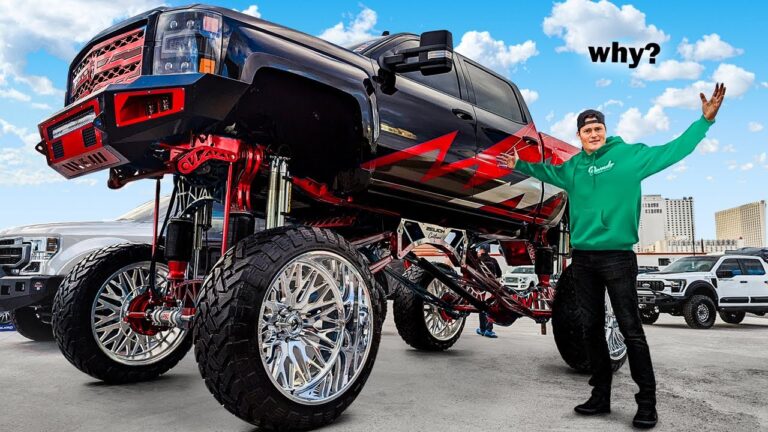U-Haul Trailers: Your Comprehensive Guide to DIY Moving and Hauling
U-Haul Trailers: Your Comprehensive Guide to DIY Moving and Hauling cars.truckstrend.com
Moving, renovating, or simply needing to transport large items can often feel like a monumental task. For millions, the solution lies in the ubiquitous orange and white armada of U-Haul trailers. More than just simple metal boxes on wheels, U-Haul trailers represent an accessible, cost-effective, and highly flexible solution for do-it-yourself movers and haulers across North America. They empower individuals to take control of their logistics, offering a diverse fleet designed to tackle everything from a studio apartment move to hauling a vehicle across state lines. This comprehensive guide will delve into the world of U-Haul trailers, exploring their types, benefits, usage, and essential considerations to ensure a smooth and successful experience.
Understanding the U-Haul Trailer Ecosystem
U-Haul Trailers: Your Comprehensive Guide to DIY Moving and Hauling
U-Haul’s trailer offerings are categorized into distinct types, each engineered for specific hauling needs. Understanding these categories is the first step in selecting the right trailer for your project.
1. Cargo Trailers (Enclosed)
These are the most popular choice for household moves due to their enclosed design, which protects belongings from weather and provides security.
- Sizes:
- 4’x8′: Ideal for small moves, dorm rooms, or extra storage. Offers 200 cubic feet of loading space.
- 5’x8′: A versatile choice for studio apartments or hauling furniture. Provides 256 cubic feet.
- 5’x10′: Suitable for one to two-bedroom apartments. Offers 390 cubic feet.
- 6’x12′: The largest enclosed trailer, perfect for two to three-bedroom homes. Boasts 540 cubic feet.

- Key Benefits: Weather protection, security, good for delicate items.
- Ideal For: Furniture, boxes, electronics, personal belongings.
![]()
2. Utility Trailers (Open)
Utility trailers are open-top, flatbed trailers designed for hauling a wide variety of items that may not fit in an enclosed trailer or require open-air transport. Many come with a built-in ramp for easy loading.
- Sizes:

- 4’x7′: Smallest utility trailer, good for light hauling like yard waste or small appliances.
- 5’x8′: Versatile for landscaping materials, ATVs, or construction debris.
- 5’x9′ with Ramp: Excellent for motorcycles, lawn tractors, or heavier equipment due to the ramp.
- 6’x12′ with Ramp: The largest utility trailer, suitable for large equipment, lumber, or multiple ATVs.
- Key Benefits: Versatility, ease of loading/unloading large items, ideal for outdoor/dirty loads.
- Ideal For: Lawn equipment, building materials, motorcycles, ATVs, open-air cargo.
3. Auto Transport Trailers (Vehicle Haulers)
Designed specifically for moving vehicles, these trailers come in two main types:
- Tow Dolly: This unit lifts the front two wheels of the towed vehicle off the ground.
- Key Benefits: More economical, lighter, easier to maneuver than a full auto transport.
- Ideal For: Front-wheel drive vehicles, short to medium distances.
- Auto Transport (Car Carrier): This is a full trailer that lifts all four wheels of the towed vehicle off the ground.
- Key Benefits: Provides maximum protection for the towed vehicle, reduces wear and tear, suitable for all vehicle types (including 4×4 and rear-wheel drive).
- Ideal For: Long-distance moves, classic cars, vehicles with mechanical issues.
The Undeniable Benefits of Choosing U-Haul Trailers
The popularity of U-Haul trailers stems from a compelling set of advantages they offer:
- Cost-Effectiveness: Renting a trailer is often significantly cheaper than hiring professional movers or even renting a large moving truck, especially for local moves or when you already own a capable towing vehicle.
- Flexibility and Control: You dictate the schedule, the loading process, and the route. This level of control is invaluable for those who prefer a DIY approach.
- Wide Availability: With thousands of locations across North America, finding a U-Haul trailer near you is usually straightforward.
- Variety of Sizes: The extensive range of trailer sizes ensures there’s a perfect fit for almost any hauling need, preventing overpaying for unused space or struggling with insufficient capacity.
- No Mileage Charges (Often for Local): For local trailer rentals, U-Haul typically charges a flat daily rate, meaning you don’t pay extra for mileage, which can be a huge saving.
- Environmentally Friendly: Utilizing your own vehicle for towing can be more fuel-efficient than driving a large, empty moving truck, especially for smaller loads.
How-To Guide: Renting and Using Your U-Haul Trailer
Navigating the U-Haul trailer rental process is straightforward, but attention to detail is key for a smooth experience.
1. Reservation and Pickup
- Reserve Early: Especially during peak moving seasons (summer, end of month), reserve your trailer well in advance online or by phone.
- Know Your Tow Vehicle: Before reserving, ensure your vehicle has the proper towing capacity, a compatible hitch ball (typically 1 7/8" or 2"), and a working lighting connection (4-way flat or 7-way round). U-Haul’s online reservation system often helps you verify compatibility.
- What to Bring: When picking up, have your valid driver’s license, credit card, and towing vehicle ready for inspection. U-Haul staff will often inspect your vehicle’s hitch, lighting, and tire pressure to ensure safety.
2. Connecting and Hitching
- Attach Coupler: Lower the trailer coupler onto your vehicle’s hitch ball. Ensure it’s fully seated and engaged, then lock the latch.
- Connect Safety Chains: Cross the safety chains under the coupler and attach them to your vehicle’s hitch receiver or frame. This prevents the trailer from separating if the coupler fails.
- Connect Wiring Harness: Plug the trailer’s electrical connector into your vehicle’s receptacle. Test brake lights, turn signals, and running lights before driving.
- Check Clearance: Ensure there’s sufficient clearance between the trailer and your vehicle, especially during turns.
3. Loading Your Trailer
Proper loading is paramount for safe towing.
- Weight Distribution: Aim for approximately 60% of the cargo weight to be in the front half of the trailer, closest to the tow vehicle. Heavy items should be placed low and centered.
- Secure Everything: Use moving blankets, furniture pads, and tie-downs (ratchet straps are highly recommended) to prevent items from shifting during transit. Shifting cargo can cause dangerous swaying.
- Don’t Overload: Adhere to the trailer’s maximum weight capacity and your vehicle’s towing capacity. Overloading is a significant safety hazard.
4. Towing Tips
- Drive Slower: Reduce your speed, especially on turns and descents.
- Increase Braking Distance: Your stopping distance will be significantly longer with a trailer. Allow ample space between your vehicle and others.
- Wider Turns: Trailers cut corners, so make wider turns to avoid hitting curbs or other obstacles.
- Practice Backing Up: Find an empty parking lot to practice backing up with the trailer. Remember, the trailer will move in the opposite direction of your steering wheel initially.
- Check Mirrors Frequently: Be aware of the trailer’s position and surrounding traffic.
- Monitor Tires: Check trailer tire pressure before and during your trip.
- Pre-Trip Inspection: Before every drive, check the hitch connection, safety chains, lights, and tire pressure.
5. Returning Your Trailer
- Return Location: For one-way rentals, return to your designated drop-off location. For local rentals, return to the pickup location.
- Inspection: The U-Haul representative will inspect the trailer for damage upon return. Ensure it’s reasonably clean to avoid potential cleaning fees.
Important Considerations for Safe and Effective Use
- Towing Vehicle Compatibility: This cannot be stressed enough. Your vehicle must have the correct towing capacity (including tongue weight), a proper hitch, and functioning wiring. Consult your vehicle’s owner’s manual.
- Insurance: Your personal auto insurance may cover liability while towing a rental trailer, but often not damage to the trailer itself or the cargo. U-Haul offers optional coverage plans like Safemove® (for cargo trailers) and Safetow® (for auto transports/tow dollies) which provide damage waivers and cargo protection. Consider these for peace of mind.
- State and Provincial Laws: Be aware of varying speed limits for vehicles towing trailers, specific lighting requirements, and other regulations in the states or provinces you’ll be traveling through.
- Fuel Economy: Expect a significant drop in your vehicle’s fuel efficiency when towing. Factor this into your budget.
- Maintenance: While U-Haul maintains its fleet, a quick visual inspection of tires, lights, and the hitch connection before you depart is always a good practice.
Potential Challenges and Solutions
- Availability Issues: During peak seasons, trailers can be scarce. Solution: Book as far in advance as possible. Be flexible with pickup dates or locations if possible.
- Towing Inexperience: Many users are new to towing. Solution: Start with a smaller trailer if possible. Watch U-Haul’s instructional videos, practice in an empty lot, and take it slow on the road.
- Improper Loading: Leads to swaying and dangerous driving. Solution: Strictly follow U-Haul’s loading guidelines, especially regarding weight distribution. Use plenty of tie-downs.
- Hidden Costs: Unexpected fees can arise. Solution: Read your rental agreement carefully. Understand policies on mileage (for one-way rentals), late returns, cleaning fees, and fuel surcharges. Inquire about optional insurance costs.
U-Haul Trailer Example Pricing Table
Note: U-Haul pricing is highly dynamic and varies significantly based on location, availability, duration, and whether it’s a local or one-way rental. The prices below are estimated ranges for typical scenarios and should be used for general guidance only. Always get a specific quote from U-Haul for your exact needs.
| Trailer Type | Size | Local Rental (Approx. Daily Rate) | One-Way Rental (Approx. Base Rate – highly variable by distance/duration) | Common Use Cases |
|---|---|---|---|---|
| Cargo Trailer | 4’x8′ | $19.95 – $29.95 | $100 – $350+ | Small moves, dorm rooms, extra boxes |
| (Enclosed) | 5’x8′ | $24.95 – $34.95 | $150 – $450+ | Studio/1-bedroom apartment, furniture |
| 5’x10′ | $29.95 – $39.95 | $200 – $600+ | 1-2 bedroom apartment, larger furniture | |
| 6’x12′ | $34.95 – $49.95 | $250 – $800+ | 2-3 bedroom home, larger loads | |
| Utility Trailer | 4’x7′ | $14.95 – $19.95 | Less common for one-way, inquire directly | Yard waste, small equipment |
| (Open) | 5’x8′ | $18.95 – $24.95 | Less common for one-way, inquire directly | Landscaping, ATVs, construction materials |
| 5’x9′ w/ Ramp | $22.95 – $29.95 | Less common for one-way, inquire directly | Motorcycles, lawn tractors, heavy equipment | |
| 6’x12′ w/ Ramp | $28.95 – $36.95 | Less common for one-way, inquire directly | Large equipment, lumber, multiple ATVs | |
| Auto Transport | Tow Dolly | $39.95 – $59.95 | $79.95 – $350+ | Front-wheel drive vehicles, shorter moves |
| Auto Transport | $54.95 – $79.95 | $129.95 – $700+ | All vehicle types, long-distance moves, classic cars | |
| Additional Potential Costs: Environmental Fee, Sales Tax, Optional Insurance (Safemove/Safetow), Hitch/Wiring Accessories (if needed). |
Frequently Asked Questions (FAQ)
Q1: Do I need a special driver’s license to tow a U-Haul trailer?
A1: Generally, no. For most U-Haul trailers, a standard driver’s license is sufficient in the U.S. and Canada. However, always check your specific state or provincial regulations, as some may have restrictions for very heavy loads or commercial purposes.
Q2: Can my SUV or pickup truck tow a U-Haul trailer?
A2: Most SUVs and pickup trucks are capable of towing U-Haul trailers, but it’s crucial to check your vehicle’s owner’s manual for its specific towing capacity (both trailer weight and tongue weight). You’ll also need a proper hitch receiver and working electrical connection. U-Haul’s website allows you to input your vehicle information to verify compatibility.
Q3: Are U-Haul trailers safe to use?
A3: Yes, when used correctly. U-Haul trailers are designed for safety and undergo regular maintenance. Safety largely depends on the user: ensuring your tow vehicle is compatible, the trailer is properly hitched, and cargo is loaded and secured correctly. Following all U-Haul instructions and safe towing practices is essential.
Q4: What’s the difference between a U-Haul Tow Dolly and an Auto Transport?
A4: A Tow Dolly lifts only the front two wheels of the towed vehicle off the ground, leaving the rear wheels on the road. It’s lighter and more economical, ideal for front-wheel drive vehicles. An Auto Transport (car carrier) is a full trailer that lifts all four wheels of the towed vehicle completely off the ground, providing maximum protection and suitability for all vehicle types, including 4x4s and rear-wheel drive.
Q5: What if my car breaks down while I’m towing a U-Haul trailer?
A5: Your personal auto insurance policy might cover roadside assistance for your vehicle. For issues related to the U-Haul trailer itself, U-Haul offers 24/7 roadside assistance. It’s wise to review your insurance coverage and U-Haul’s policies before your trip.
Q6: Can I return a local rental trailer to a different U-Haul location?
A6: Generally, no. Local rentals are typically picked up and returned to the same location. One-way rentals are designed for returning to a different, pre-specified U-Haul center.
Conclusion
U-Haul trailers stand as a cornerstone of the DIY moving and hauling landscape, offering unparalleled flexibility, affordability, and a diverse range of options for virtually any task. From the secure confines of a cargo trailer protecting cherished belongings to the robust utility trailer hauling construction materials, they empower individuals to take charge of their logistics. By understanding the types available, meticulously planning your rental, adhering to crucial safety guidelines, and approaching the task with practical knowledge, you can transform what might seem like a daunting challenge into a manageable and rewarding endeavor. U-Haul trailers don’t just move your stuff; they move your projects forward, one successful haul at a time.





